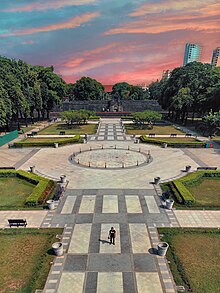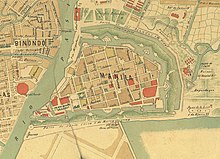Plaza Moriones (Intramuros)
The Plaza Moriones is a public square in Intramuros , Manila . It is located in front of the entrance to Fort Santiago and is one of three large squares in Intramuros, next to the Plaza de Roma , which is behind the fortress, and the Plaza de Armas within the fortress, with which it is often confused.
history
The square has been on city maps of Manila since at least 1671, but was originally called Plaza de la Fuerza and served the soldiers in Fort Santiago as a parade ground. At that time the place was neither planted nor built up. After the fort was damaged in the Manila earthquake in 1863, the square was temporarily used to house military units. In 1875, however, the square was again free of buildings. In 1898 at the latest it was named Plaza del General Moriones , after Domingo Moriones y Muralla , who was Spanish Governor General from 1877 to 1881.
Even during the American colonial era, the square was still used for military purposes. It served as a parade ground. In the 1930s, according to a manuscript by the American anthropologist H. Otley Beyer, the United States Army, which was then stationed in Fort Santiago, took over the site and built soldiers' quarters on it.
After Intramuros was completely destroyed in the Battle of Manila towards the end of World War II , the Plaza Moriones was again converted into open space and served as a parking lot for cars and coaches for years after the war. The reconstruction of Intramuros eventually led to the redesign of the square. Planning began in 1973 and the work was initially completed in 1993. Another redesign took place in 2017.
architecture
The Plaza Moriones was originally a free, open area that was overgrown with grass at least as early as 1875. Around 1903, although the square was still considered an "uninteresting" area, some trees grew on its edge, and aerial photographs from the 1930s show that trees grew on the north side of the square, near the entrance to the fortress, while the south side largely open terrain remained. After the Second World War, the area of the square was largely overgrown with grass again. In 1983 bushes were planted. In addition, concrete paths and a fountain were laid in the 1980s.
Plans for redesign were first drawn up in 1973 as part of the development plan for Intramuros. The Spanish government planned to use the square as a "cultural and recreational area". In the early 1990s, the landscape architect Dolly Perez was commissioned to redesign the square. Perez's plans, completed in 1993, turned the square into a park with plants typical of 19th century parks. As part of the redesign, trees were planted and the park's sidewalks and walls were made from building materials such as adobe and brick to adapt to the surroundings. Plaza Moriones kept this appearance for 25 years. It has become a popular destination for picnics, wedding receptions, and dog walkers.
In 2014 a second redesign of the Plaza Moriones began. It was part of a ₱ 240 million investment to renew Fort Santiago as a whole, as part of the broader long-term renewal plan for Intramuros. The renewed Plaza Moriones was reopened by the Department of Tourism (DOT) on April 17th, 2017. The work was financed by the Tourism Infrastructure and Enterprise Zone Authority (TIEZA), which is affiliated to the DOT.
As part of the renovation of the square, with the aim of restoring the square to its original function as a parade square, the square was paved with granite and borders were created. Near the entrance to Fort Santiago there are borders that are planted with red frangipani and illuminated by capiz shell lamps. This allowed an unobstructed view of the fort's gate from both Santa Clara Street, which runs at the south end of the plaza, and Manila Cathedral at its north end.
The redesign was controversial and sparked criticism from the city guide and cultural activist Carlos Celdran . He complained that there had been "plastering over his heart" after discovering these changes when he returned from a trip abroad. Celdran later said the result of the renovations was flat, anonymous and had nothing to do with the character of Intramuros in the story, he even called the redesigned plaza "Plaza of TriNoma " and condemned the project as a waste of taxpayers' money. The redesign was carried out without a prior public consultation because such a consultation is not required by law. According to the architect Auguste F. Villalon, residents who had regularly used the park complained about the loss of the park-like atmosphere, especially the lack of greenery and open spaces in Manila. In her defense, the Intramuros Administration, an institution of the Department of Tourism of the Philippines, said she had interviewed landscape architects and conservation experts when the first planning was made in 2014.
Coordinates: 14 ° 35 ′ 35.9 ″ N , 120 ° 58 ′ 16.5 ″ E
supporting documents
- ^ A Walk in the Park: 10 Manila Parks to Visit . In: SPOT.ph . Summit Media . Archived from the original on February 22, 2014. Retrieved July 2, 2013.
- ↑ a b c d e f g VERA FILES FACT SHEET: Plaza Moriones in Intramuros , Vera Files . May 12, 2017. Archived from the original on April 7, 2020. Retrieved on April 6, 2020.
- ↑ Fort Santiago . Intramuros administration. Archived from the original on July 25, 2013. Retrieved July 2, 2013.
- ↑ a b c d e Bueno, Anna: What you need to know about the Intramuros rehabilitation , CNN Philippines . March 31, 2017. Archived from the original on April 7, 2020. Retrieved on April 6, 2020.
- ↑ a b c d e Villalon, Augusto F .: Updating Plaza Moriones in Intramuros . In: Philippine Daily Inquirer , March 6, 2017. Archived from the original on April 7, 2020. Retrieved April 6, 2020.
- ↑ Parrocha, Azer N .: Fort Santiago's Paseo Soledad, Plaza Moriones facelift get . In: Manila Bulletin , April 18, 2017. Archived from the original on April 7, 2020. Retrieved on April 6, 2020.
- ^ Chee Kee, Raoul J .: Why you should check out Intramuros now . In: Philippine Daily Inquirer , January 22, 2020. Archived from the original on January 22, 2020. Retrieved on April 9, 2020.


